Since I live along a fairly busy road, I have been trying my hand at selling small garden ornament items like my Cow & Bull Garden Ornament and my Walkway Garden Sign from my front lawn.
During the winter months, I also try to dream up and build something new and unique to put out on the front lawn for the next summer.
Last winter I noticed that I had accumulated a sizable collection of small 5 volt DC motors which I had salvaged from a bunch of old CD ROM drives.
Trying to think about what I could do with these motors, I played around with them a little bit to come up with some ideas. It was during these experiments that I realized that when one of these motors were hooked up to a solar cell that I had laying around, it seemed to spin the motor at a very good rate. From there, an idea was formed.
I remembered seeing lawn ornaments in the past that looked like flowers that spun in the wind. But instead of having the flower spin in the wind, why not have the sun do it?
After a little bit of experimenting with some scrap wood and some sheet aluminum that I had laying around, the Solar Flower was born.
I've since built several of these flowers and they have proven to be very popular sellers.
Step 1: What Do You Need to Build This?
To make the flower, you need to gather the following items:
Electronic Components:
- One Solar Cell (400mW 4.6V) - Digikey part number 1471-1517-ND
- One 5 volt DC motor - I pulled mine from an old CD ROM drive - remember to also keep the pully that is attached to the motor spindle.
- Two feet of 2 wire hook up wire
Materials
- Two 7.5" X 6.5" piece of 0.5" hardwood - for the flower pot sides
- Two 6.5" X 6.5" piece of 0.5" hardwood - for the flower pot sides
- One 6" X 6" piece of 0.75" plywood for the flower pot top
- One 5" X 5" piece of 0.5" piece of hardwood for the flower pot base
- One 3" X 3" piece of 0.5" piece of hardwood for the flower pot bottom
- One 16" length of 1-inch dowel for the flower's stem
- Two 7" X 6" pieces for 0.75" plywood for the leaves
- One 2" X 2" piece of 0.75" plywood for the motor mount
- One 2" X 2" piece of 0.5" piece of hardwood for the motor mount
- Two 10" X 10" pieces of 38 gauge sheet aluminum for the flower - I got mine from www.stockade.ca
- Paint
- Artist's Paint Brush
- Wood Glue
- Gorilla Glue (for the sheet aluminum)
- 5 Minute Epoxy
- Hot Glue Sticks
- Approximately 1 pound of river stones - I got those from my local dollar store
Tools
- Miter Saw
- Table Saw
- Drill Press with a 1-inch drill bit and a 3/8 inch drill bit
- 2-inch diameter hole cutter
- Variable speed drill with 1/4 inch drill bit
- Nail gun with 1/2 inch nails
- Soldering iron and solder
- Clamps
- Wire Strippers
- Scissors
- Hot glue gun
Step 2: Cutting Out the Pieces
We will start the project by building the flower pot.
We'll first start by taking the two pieces of 7.5" X 6.5" hardwood and cut a 15-degree angle off of the sides with a miter saw such that you get a trapezoid shape where the top of the trapezoid is 7.5 inches wide and the bottom of the trapezoid is 4 inches wide.
Next, take the two pieces of 6.5" X 6.5" hardwood and also cut a 15-degree angle off sides of the wood with a miter saw so that you get a trapezoid shape where the top of the trapezoid is 6.5 inches wide and the bottom of the trapezoid is 3 inches wide.
With the sides for the flower pot cut out, we now need to cut out the top of the pot. With a table saw cut a 6" X 6" piece of 0.75" plywood. When cutting the plywood, set your saw blade to a 15-degree angle and cut the plywood such that you will see a square shape when you look at the plywood from a top, but a trapezoid shape when you view the plywood from the sides.
Next, reset your table saw blade 90 degrees and cut a 5" X 5" piece of 0.5" piece of hardwood for the flower pot base
Finally, cut a 3" X 3" piece of 0.5" piece of hardwood with the table saw which will be used for the bottom of the flower pot.
Step 3: Building the Pot
Now that the pieces cut out, we can start assembling the pot.
Start by taking one of the side pieces that are 7.5 inches at the top and join it with one of the 6.5-inch pot side pieces with some wood glue. Make sure that the outside edge of the 7.5-inch piece is facing outwards. Secure the to pieces together with some brad nails.
Next, take the other 6.5-inch wide pot side and attach it to the other side of the 7.5-inch pot side with some wood glue and brad nails. When you look at the 3 sides from the top, you should start to see a square shape forming.
Complete the pot body by attaching the remaining 7.5-inch pot side to the two free ends of the 6.5 pot sides with white glue and nails.
At this point, you should have a pot that is a trapezoid from all side but is square when you look at it from the top looking down.
Step 4: Preparing the Pot Top and Bottom
The next step is to attach the top and bottom of the pot.
The first thing that we need to do is drill a hole into the top and bottom to allow for the installation of the flower's stem
To drill the holes, first, mark the centers of the top and bottom pieces by drawing diagonal lines from corner to corner so that you have an X drawn on the wood with the middle of the X marking the dead center of the wood.
With the centers marked, drill a one-inch hole through the centers with the drill press and a one-inch drill bit.
Step 5: Completing the Pot
With the holes drilled the pot can now be fully assembled.
Start by placing the pot bottom into the bottom of the pot and nail it into place with brad nails.
After the bottom is installed, apply some wood glue along the four edges of the pot top and carefully place it into the pot body. The top of the pot should be one or two inches from the top lip of the pot body. Nail the top in place with brad nails. Allow the glue to dry.
Paint the pot in the color of your choice. While painting the pot, this would also be a good time to paint the base of the pot too.
Step 6: Preparing the Stem
With the flower pot built, the next step is to create the stem for the flower.
The stem is simply a 16-inch length of 1-inch birch doweling. In order to allow for wiring that we will be adding in a later step, we will need to add a small groove along one side of the dowel.
To add this groove, we will use a grooving bit on our router and we will run the dowel through the router.
One word of caution - When running the dowel through the router, there will be some torque from the router that will cause the dowel to want to rotate. If you let it get away from you, you will end up with a bit of a spiral groove in the dowel - definitely not what we want! Therefore, make sure you have a secure hold of the dowel when running it through the router.
Once the groove is added, give the stem a couple of coats of green paint.
Step 7: Attaching the Stem
Once the stem is painted, we next want to insert the stem into the flower pot.
Before we can do that, we need to first add some weight to the pot and create an access hole for the wire to be attached to the solar cell.
The first step is to add some weight to the bottom of the pot. The weight is needed to make the pot a bit bottom heavy in order to keep the flower from tipping over on windy days. To add weight, simply pour a couple of pounds of river stones into the pot through the 1-inch hole in the top of the pot. Make sure that the stones don't pour out of the bottom hole in the pot.
Once the stones have been added, drill a 3/8 inch hole in the top of the pot just an inch away from one of the sides of the pot.
Next, take a length of 2 wire hook up wire (at least 2 feet in length), put a bend into one end of the wire so that the wire looks a bit like a fish hook and put the bent section of wire through the one-inch hole in the top of the pot
Fish the wire through the 3/8 hole and pull few inches of wire out of the 3/8 inch hole.
Finally, insert the stem into the 1-inch hole of the pot, making sure that the groove in the stem is pointing away from the 3/8 inch hole in the top of the pot and make sure that the wire is seated into the groove of the stem.
Definitely make sure that the wire that is sticking out of the 3/8 inch hole doesn't disappear.
Push the stem through the pot until the bottom of the stem is through the hole in the bottom of the pot.
Secure the stem to the pot with some brad nails.
Step 8: Attaching Base
With the stem attached, we finish the flower pot off by installing a base to the bottom of the pot.
While you could omit the base if you really wanted to, I found that the flower stayed upright a lot better on windy days with this base installed.
To install the base, apply some wood glue to the bottom of the pot and apply the base to the bottom of the pot.
Center the base on the pot bottom and secure the base with some brad nails.
Step 9: Building the Leaves
With the pot and stem in place, we start working upwards on the flower by putting together the leaves for our flower.
Using the leaf template above, we trace out two leaves on a piece of 3/4 inch plywood. We then cut the leaves out with a scroll saw.
We then join the leaves them together at the stems with some wood glue and brad nails.
When the glue has dried, give the leaves a couple of coats of green exterior paint.
Step 10: Attaching Leaves to Stem
We next attach the leaves to the flower's stem.
Start by positioning the hookup wire into the groove that has been cut into the stem.
Position the leaves about 6 inches from the top of the stem and secure it to the back of the stem with brad nails.
Be careful that the nails don't pierce the insulation of the hook wire.
Step 11: Making the Motor Mounts
With the leaves in place, we continue to move upward on the flower.
In order to allow for the mounting of the motor to drive the flower petals and for the flower petals themselves, we need to build a mount for them.
Start by taking a 3/4 inch piece of plywood and cut out a 2-inch diameter circle with a 2-inch hole cutter.
The circle that you have just cut out will have a drilled hole in the center it that would have been left by the hole cutter.
Typically the DC motors that are used in CD ROM drives are around an inch in diameter. With that in mind, we need to cut a one-inch diameter hole in the center of our 2-inch circle. Using the drilled hole as a center guide, drill a hole with a 1-inch drill bit.
With the motor mount made, we need to make a mount for the motor mount to attach to the stem. To do that we take a half inch thick piece of scrap hardwood and cut out a 2 inch half circle with a scroll saw.
Drill a 1-inch hole in the center of the half circle.
With the 2 main pieces of the motor mount cut out, assemble the completed motor mount by attaching the half moon hardwood piece in the middle of the 2-inch circle. Secure the 2 pieces together with glue and brad nails.
Once the glue has dried, give the completed motor mount a couple of coats of green paint.
Step 12: Installing the Motor
Once the motor mount is built, install it onto the stem of the flower by inserting the top of the stem through the hole that we drilled into the half circle part of the motor mount. Make sure that the hookup wire is also inserted through the half circle of the motor mount.
Also, make sure that the 2-inch circle of the motor mount is facing the front of the flower pot.
Secure the motor mount to the stem with some brad nails.
Next, feed the hookup wire through the 1 inch opening of the front of the motor mount and strip a half inch of insulation from the wires.
Take the CD ROM motor and solder the leads from the motor to the hookup wire. When the solder has cooled, give the soldered joints some weatherproofing by covering them with some hot glue.
Insert the motor into the 1 inch opening of the motor mount and secure it in place with some hot glue. When the glue dries, further secure the wires and further weatherproof the motor by applying some more hot glue to the back of the motor through the rear of the motor mount.
Step 13: Making the Flower
With the motor installed, we next focus our attention on the flower itself.
Starting with 2 rolls of sheet aluminum, cut out two 10" X 10" sheets of aluminum from the rolls.
To add a little extra bit of stiffness to the flower, we need to adhere to the 2 sheets together. Brush on an even coat of Gorilla Glue onto the back of one of the sheets and attach it to the back of the other sheet of aluminum. Clamp the 2 pieces together until the glue is dry.
Once the glue is dry, place the above template of the flower on top of the aluminum sheets and trace the outline of the flower with a marker. When doing the tracing also make sure to mark the center of the flower.
Cut out the flower with a pair of scissors.
Step 14: Painting the Flower
Now at this point, you just leave your flower as is with one solid color. But I like to have my flower to have multi-colored petals, mainly because I like the effect it creates when the flower is spinning.
To paint the petals, I just give each petal a coat of poster paint in a color of my choice, You may need to apply a couple of coats of paint on each petal to ensure that each petal is of a uniform color
Step 15: Attaching the Center of the Flower
Now that we have painted the petals of our flower, we need to finish the flower off by adding a center (or, for you gardeners, the pistil).
Taking a leftover piece of sheet aluminum, cut out a 3-inch diameter circle.
Next, with a fine tipped brush and using a fluorescent paint color, paint a spiral pattern onto the aluminum circle.
The idea is that the spiral pattern will create a neat effect when the flower is turning.
Once the paint is dry, apply a little bit of epoxy to the back of the circle and attach the circle to the flower.
Step 16: Attaching Flower Motor Mount
As a final step in completing the flower, we need to attach a motor mount to the flower so that it can be attached to the CD ROM motor.
With the epoxy applied, insert the motor drive pulley that you salvaged from the CD ROM into the hole drilled into the flower.
Make sure that the epoxy does not fill the center hole of the pully (I found a toothpick helpful clearing epoxy from the hole).
Allow the epoxy to set and the flower is done.
Step 17: Installing the Solar Cell
With the motor all wired up, the last step in completing the electrical circuit is to connect the solar cell to the motor.
To start we need to create a little mount to attach the solar cell to the flower pot. The mount can be created by cutting out a 1/2 inch X 3-inch strip of 1/2 inch hardwood. Give the mount a quick coat of paint.
Once the paint has dried, attach the mount to the top of the flower pot with some wood glue. Make sure that the mount is attached just in front of the wire access hole that we had drilled earlier.
With the mount in place, solder the solar cell to the two wires that are coming out of the access hole in the pot.
Once the solder has cooled, put a dab of hot glue on the soldered connections to serve as weatherproofing.
Finally, glue the solar cell to the mount.
Step 18: Finishing Up
Now that the flower is all assembled, the final step is to balance the flower.
I find that balancing the flower will make the initial startup of the flower easier since the motor would not have to overcome the initial inertia if one of the petals of the flower is heavier than the others.
To balance the flower, give it a couple of gentle spins with your hand. Every time it stops, you may find it will always stop with the same petal pointing down. That is the "heavy" petal. With a pair of scissors, trim a little bit of aluminum from the outer edge of that petal, and give the flower a couple more spins.
Keep trimming a little bit of material from the heavy petals until when you spin the flower, the flower doesn't stop on a particular petal on the bottom.
Finally, give the circuit a quick test to make sure that the motor and solar cell are working properly. This can be done by just simply shining a light bulb over the solar cell. If everything is hooked up right, the flower should start spinning.
And with that, your flower is ready for spending its days in the sunshine, providing a visually appealing effect to any passerby.










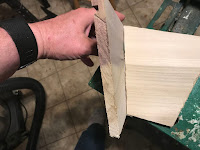












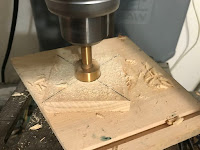





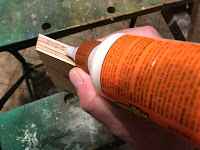















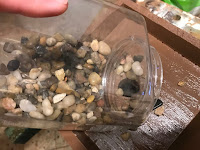


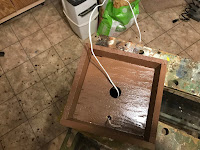









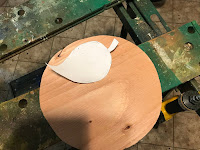
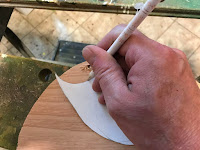



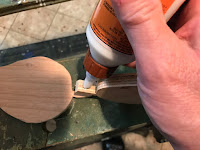
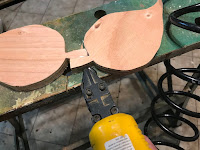

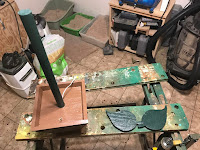

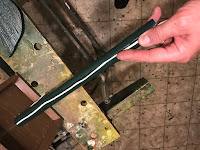


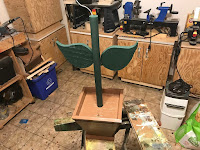


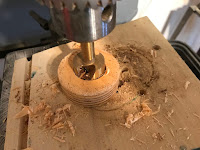
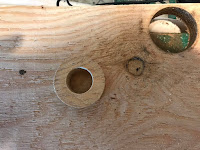











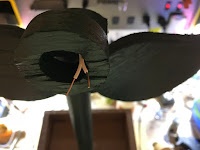
























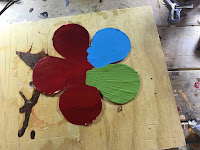



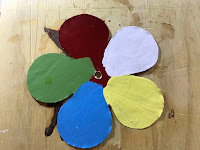







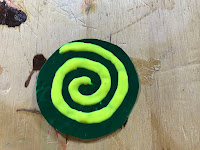


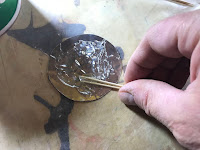






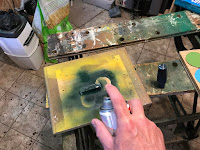






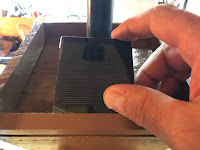




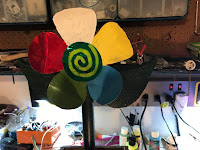

No comments:
Post a Comment